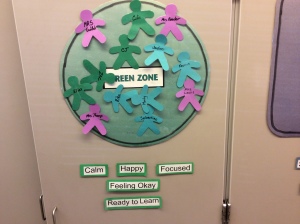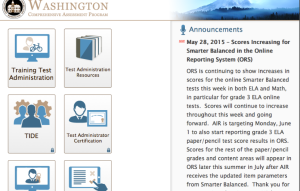H3 – Honor the classroom/school community as a milieu for learning. Teacher candidates implement classroom/school centered instruction, including sheltered instruction that is connected to communities within the classroom and the school, and includes knowledge and skills for working with others.
Upon reflection of the H3 principle I’ve come to think about how H3 encompasses the focus of schools and how teaching students involves more than math facts and reading fluency. Throughout this my student teaching year I’ve come to realize that I have some strong beliefs about education and teaching. Some of those attitudes will be shared in this paper. For starters, I believe that each student has a voice and should be heard from. This may seem like a basic simple obvious reply, however in my observation of many teachers over the years I’ve come to realize that not all teachers share my thoughts.
One way I like to do this is to start the day with an informal discussion by incorporating a morning meeting to the class. The Responsive Classroom approach to morning meetings was created in 1981 by a group of teachers (Responsive Classroom website). The central idea in the Responsive Classroom program is the belief that academic and social aspects are equally important for any student. This veers from traditional thinking where the academic aspect is emphasized, and social skills are assumed to have been already taught at home. Many students need on-going, and frequent reminders about social skills and what the expectations are around their behavior. The Responsive Classroom approach found in the morning meeting is one way to prompt students into practicing those skills on a daily basis.
The morning meetings although informal, are providing students with a wealth of skills. First they are learning about the importance of social skills by checking in and greeting each other. Realizing the importance of knowing what emotional state someone else is in can be tremendously beneficial. Secondly the students get to participate and be part of the meeting: engagement is high for these meetings as students are able to share information about themselves, their feelings, and the topic or question at hand. The routine involved is also significant in that it helps all students settle into their classroom, knowing what to expect and ready to learn and get started with their day.
The Responsive classroom incorporates seven ‘guiding principles’, that include some of the following ideas: the idea that social growth in students can help with their academic growth, realizing the individuality of students, positive talk, and a sense of community are important factors to help students learn (Responsive Classroom website). These are ideas I have used throughout my time as a Paraeducator and a student teacher and strongly believe in their effectiveness.
The Responsive Classroom is an evidence-based practice that has been reviewed by CASEL (the Collaborative for Academic, Social and Emotional Learning) who reported that the Responsive Classroom approach to teaching helped to advance and strengthen SEL (social and emotional learning) as well as provide train the trainer and assessments to improve SEL (CASEL Rating guide, CASEL website). “It has been recognized by {CASEL} as one of the most well-designed, evidence-based social and emotional learning programs” (Responsive classroom website).
The Responsive Classroom methodology has been also been evaluated extensively by Dr. Rimm-Kaufman, who reported that students participating in this approach showed greater social skills, happiness about school and learning, as well as improved academic performance (Rimm-Kaufman, S., 2010).
The Responsive Classroom morning meetings are highly effective I will definitely implement in my classroom as I move into my first year teaching. I look forward to using it as a way to work with the kids, build rapport, and help their social skills all at the same time.
In addition our district has chosen to use the Zones of Regulation to help students recognize their own and others emotional states (Zones of Regulation website zonesofregulation.com). In this program each of the four zones is associated with a level of how much a person is or is not feeling in control. Students are asked to identify their own feeling and share when asked by a peer or teacher. I’ve found it to be incredibly helpful especially for helping the students recognize others emotions (including the teachers) and how they change from day-to-day.

The evidence presented above is a screenshot of the green zone from the Zones of Regulation program. In my current classroom we blend the Responsive Classroom morning meeting with the Zones of Regulation in an effort to help our students who have Emotional or Behavior disorders get daily practice working with others and learning about how both emotions and behavior can have an effect on the day and learning in the classroom environment.
I have been using the Responsive Classroom morning meeting and the Zones of Regulation for a number of years now and am very familiar with the concepts behind both programs. My self-assessment of understanding and ability to use these programs would be at a competent level. To me it clearly demonstrates one way in which the classroom is the natural setting for student learning about classroom rules, procedures, as well as feelings and emotions can occur in a safe and contained area with the proper structure in place.
Because I am familiar with the Responsive Classroom and Zones of Regulation programs I am comfortable to ask or answer additional questions that might come up that are outside of the general theme of morning meeting. An example would be venturing to discuss a behavior concern that happened the previous day, how students felt during that moment, what they could have done differently and even checking in to see if anyone else has ever felt that way in an effort to open up the communication between peers.
In order to become more effective in this practice I would need additional training (in particular with the Responsive Classroom techniques). I would like to get to a point where I could be a ‘train the trainer’ instructor to help more general education teachers realize the easy and powerful strength behind combining these two effective programs. I think that if more teachers realized the effect that combining both academic and social skills could have on their classrooms they would be anxious to implement it and would agree about the importance of the classroom not only for academic but also for social and emotional development for each student.
References:
Responsive Classroom. Northeast Foundation for Children. Responsive Classroom
Rimm-Kaufman, S., (2010). The Responsive Classroom approach for improving interactions with children. Better: Evidence-Based Education. Winter p. 10-11. Retrieved from http://www.bestevidence.org/word/Better-Magazine-Responsive-Classroom.pdf
CASEL (the Collaborative for Academic, Social and Emotional Learning) http://www.casel.org/guide/programs/responsive-classroom/
Rimm-Kaufman, S., (date unknown). A leading SEL program gets positive results – but only if it’s used. Retrieved from CASEL website http://www.casel.org/news/2014/3/19/a-leading-sel-program-gets-positive-resultsbut-only-if-its-used
Zones of Regulation http://www.zonesofregulation.com/

